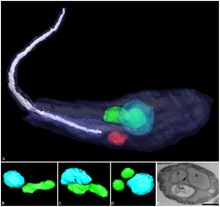Angomonas deanei
| Angomonas deanei | |
|---|---|
 |
|
| Three-dimensional reconstruction of Angomonas deanei containing a bacterial endosymbiont (green) near its nucleus (blue). | |
| Scientific classification | |
| Domain: | Eukaryota |
| (unranked): | Excavata |
| Phylum: | Euglenozoa |
| Class: | Kinetoplastea |
| Order: | Trypanosomatida |
| Genus: | Angomonas |
| Species: | deanei |
| Binomial name | |
|
Angomonas deanei (Carvalho 1973) Teixeira & Camargo 2011 |
|
| Synonyms | |
|
Crithidia deanei Carvalho 1973 |
|
Crithidia deanei Carvalho 1973
Angomonas deanei is a flagellated trypanosomatid. It is an obligate parasite in the gastrointestinal tract of insects, and is in turn a host to symbiotic bacteria. In fact the bacterial endosymbiont maintains a permanent mutualistic relationship with the protozoan such that it is no longer able to reproduce and survive on its own.
The species name was accepted as Crithidia deanei until 2011, when phylogenetic analysis revealed that it belongs to the genus Angomonas, thereby becoming Angomonas deanei. The symbiotic bacterium is a member of the β-proteobacterium that descended from the common ancestor with the genus Bordetella, or more likely, Taylorella. The two organisms have depended on each other so much that the bacterium cannot reproduce and the protozoan can no longer infect insects when they are isolated. Thus, this organismal association is a fine model for the evidence of the endosymbiotic theory in nature, which explains the origin of eukaryotic cell organelles such as and plastids from individual prokaryotes.
The body of Angomonas deanei is elliptical in shape, with a prominent tail-like flagellum at its posterior end for locomotion. The bacterial endosymbiont is inside its body and is surrounded by two membranes typical of Gram-negative bacteria, but its cell membrane presents unusual features, such as the presence of phosphatidylcholine, a major membrane lipid (atypical of bacterial membranes), and the highly reduced peptidoglycan layer, which shows reduced or absence of rigid cell wall. The cell membrane of the protozoan host contains an 18-domain β-barrel porin, which is a characteristic protein of Gram-negative bacteria. In addition it contains cardiolipin and phosphatidylcholine as the major phospholipids, while sterols are absent. Cardiolipin is a typical lipid of bacterial membranes; phosphatidylcholine, on the other hand, is mostly present in symbiotic prokaryotes of eukaryotic cells. For symbiotic adaptation, the host trypanosome has undergone alterations such as reduced paraflagellar rod, which is required full motility of the bacterial flagella. Yet the paraflagellar rod gene PFR1 is fully functional. The bacteria are known to provide essential nutrients to the host, and provide electron transport system for the production of cellular energy, the ATP molecules through its glycosomes. The bacteria synthesise amino acids, vitamins, and haeme for the protozoan. In return the protozoan offers its enzymes for the complete metabolic pathways for the biosysnthesis of amino acids, lipids and nucleotides, that are absent in the bacterium. Phosphatidylinositol, a membrane lipid required for cell-cell interaction, in the bacteria is also synthesised by the protozoan. Thus the two organisms intimately share and exchange their metabolic systems. When the protozoan is removed off of the bacterium using antibiotics, it loses its infectivity to insects, obviously due to the altered glycosylphosphatidylinositol (gp63) in the protozoan flagellum.
...
Wikipedia
